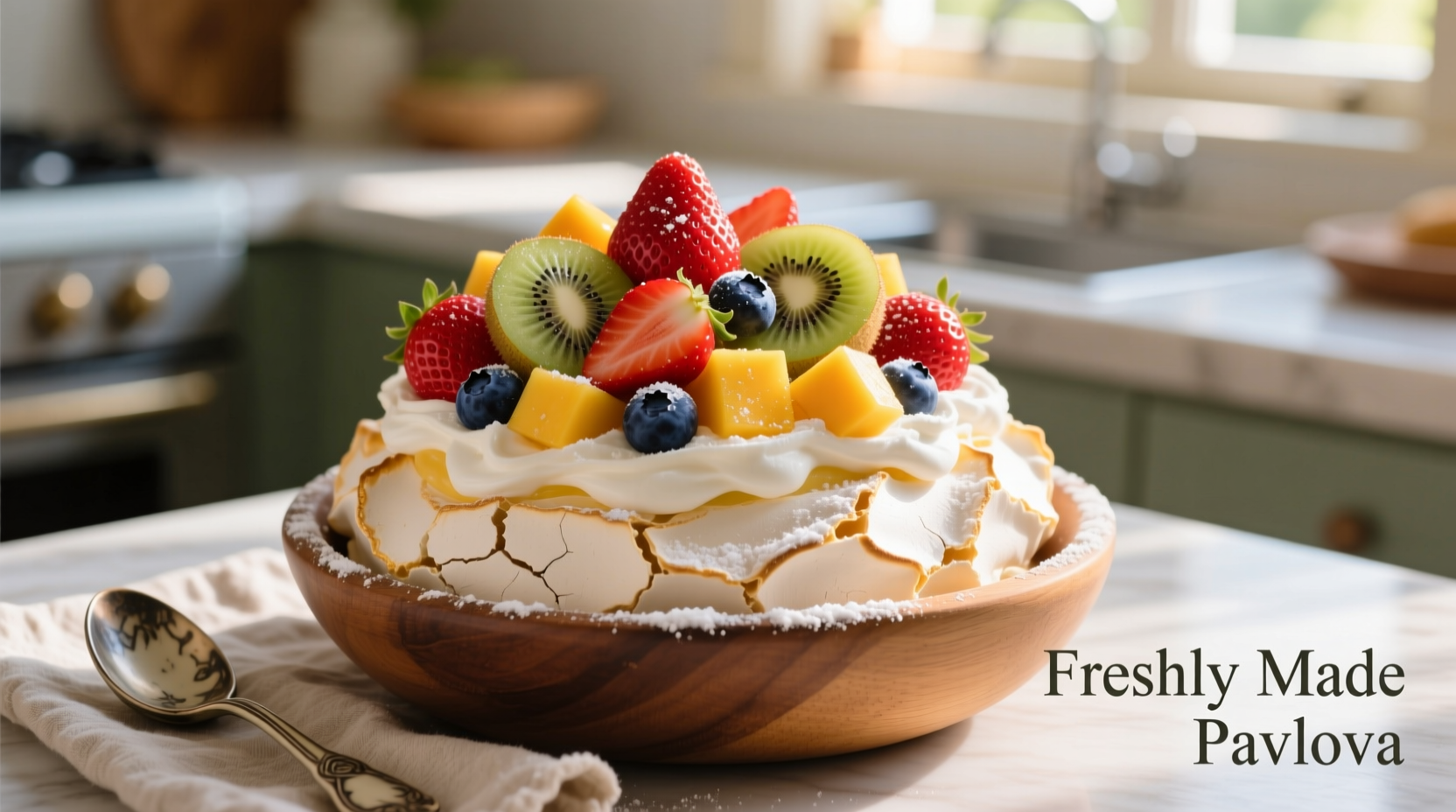The Complete Sensory Experience of Pavlova
When you first encounter a perfect pavlova, your senses are greeted with a visual spectacle of crisp, golden-brown meringue shell dusted with fine sugar crystals. But the true magic happens when your fork breaks through that delicate exterior. That initial crunch gives way to an interior so light and pillowy it practically dissolves on your tongue. This textural contrast defines the pavlova experience—crisp yet tender, substantial yet ethereal.
Breaking Down the Flavor Profile
Understanding what pavlova tastes like requires examining its three distinct components working in harmony:
The Meringue Base: More Than Just Sweet
Contrary to what many expect, quality pavlova isn't cloyingly sweet. The meringue base delivers a subtle sweetness with delicate vanilla undertones and sometimes a hint of citrus from the vinegar or lemon juice in the recipe. The sugar doesn't overwhelm but rather enhances the airy texture. When properly made, you'll detect a faint toasty note from the gentle baking process—a result of the Maillard reaction occurring at the meringue's surface.
Texture: The Defining Characteristic
Texture is where pavlova truly distinguishes itself from other desserts. The crisp outer shell (about 1/8 inch thick) provides that satisfying initial crunch, while the marshmallow interior offers a melt-in-your-mouth quality that's neither sticky nor wet. This unique textural combination—crisp yet soft, structured yet dissolving—is what makes pavlova unforgettable. Professional pastry chefs note that humidity significantly impacts this texture balance, which explains why pavlova can vary dramatically depending on climate and preparation technique.
| Texture Element | Quality Indicator | Common Issues |
|---|---|---|
| Outer Shell | Thin, crisp, lightly golden | Too thick, burnt, or soggy |
| Interior | Soft, marshmallow-like, slightly sticky | Dry, crumbly, or overly wet |
| Overall Structure | Holds shape but yields gently to pressure | Collapses easily or too rigid |
How Toppings Transform the Taste Experience
While the meringue base provides the foundation, pavlova's complete flavor profile comes alive with traditional toppings. Fresh kiwi, strawberries, and passionfruit add bright acidity that cuts through the sweetness, creating a perfect balance. Whipped cream contributes richness that complements rather than overwhelms the delicate meringue. In Australia, you'll often find native fruits like finger limes adding unique citrus bursts, while New Zealand versions frequently feature manuka honey drizzle for complex floral notes.

Regional Variations and Their Taste Differences
The Australia-New Zealand rivalry extends to how each country prepares this iconic dessert, resulting in subtle but noticeable taste differences:
| Characteristic | Australian Style | New Zealand Style |
|---|---|---|
| Texture | Slightly crispier shell, drier interior | Softer shell, more marshmallow-like interior |
| Sweetness | More pronounced sugar crust | Subtler sweetness, often with cornstarch |
| Traditional Toppings | Kiwifruit, strawberries, passionfruit | Seasonal berries, cream, sometimes pineapple |
Historical Evolution of Pavlova's Flavor Profile
The dessert's taste has evolved since its creation in the 1920s-1930s, named after Russian ballerina Anna Pavlova. Early versions were simpler meringue nests, but over time, chefs refined the recipe to achieve that signature texture contrast. According to culinary historians at the Museum of New Zealand Te Papa Tongarewa, the addition of vinegar or citrus helped stabilize the meringue while contributing subtle flavor notes that became integral to the dessert's character. The National Library of Australia documents show that Australian versions gradually incorporated more tropical fruits as refrigeration improved, expanding the flavor profile beyond basic cream and berries.
How Pavlova Compares to Similar Desserts
Many confuse pavlova with other meringue-based desserts, but the taste experience differs significantly:
- Meringue cookies are uniformly crisp throughout, lacking the soft interior that defines pavlova
- French meringue tends to be sweeter and more one-dimensional in texture
- Marshmallows share the interior texture but contain gelatin and corn syrup, giving them a different mouthfeel and more artificial sweetness
- Angel food cake has a similar airiness but incorporates flour, creating a more structured crumb
Identifying Quality Pavlova: What to Look (and Taste) For
Not all pavlovas deliver the ideal taste experience. Here's how to identify a truly exceptional one:
- Visual inspection: Look for an evenly golden exterior without dark spots or cracks
- Texture test: It should yield slightly when gently pressed, not collapse or feel rock-hard
- Flavor balance: The sweetness should be moderate, allowing the vanilla and fruit notes to shine through
- Freshness indicator: Best consumed within 24 hours of preparation for optimal texture
Maximizing Your Pavlova Experience
To fully appreciate what pavlova tastes like, serve it immediately after topping. The contrast between the cool cream, fresh fruit, and room-temperature meringue creates a dynamic sensory experience. Professional pastry chefs recommend adding fruit just before serving to prevent the meringue from becoming soggy. For the most authentic experience, try it with seasonal local fruits that complement rather than overpower the delicate meringue base.











 浙公网安备
33010002000092号
浙公网安备
33010002000092号 浙B2-20120091-4
浙B2-20120091-4